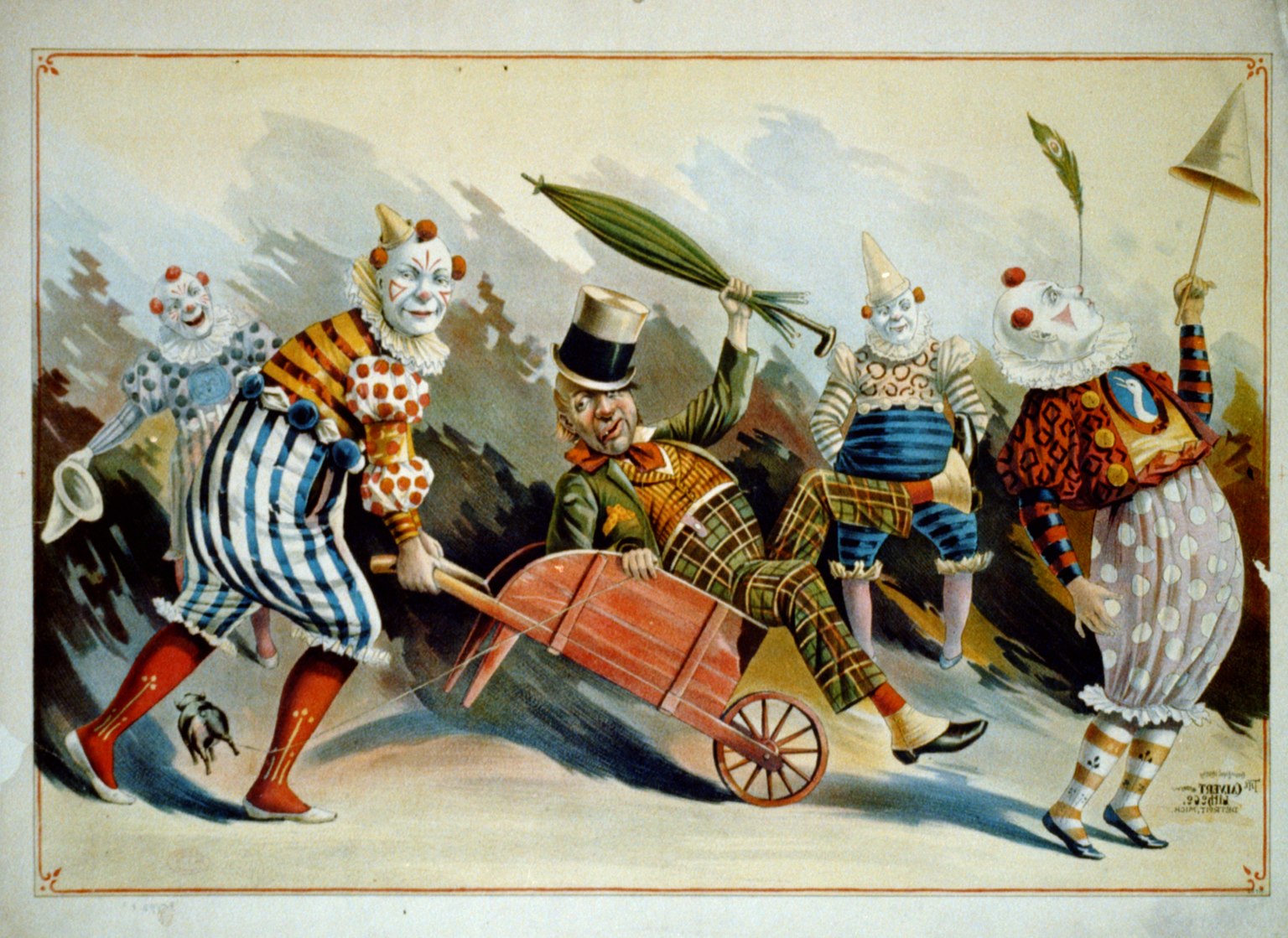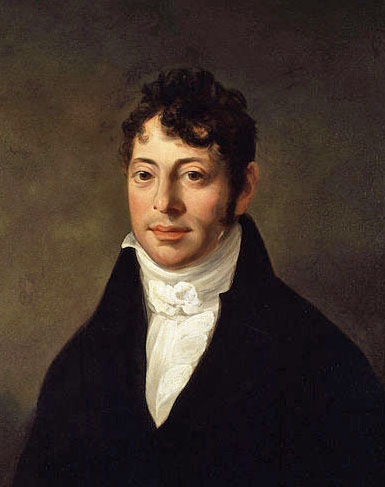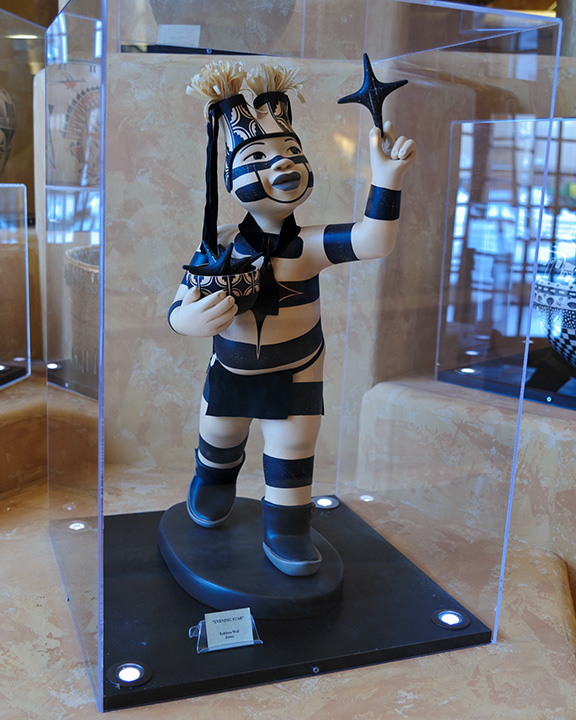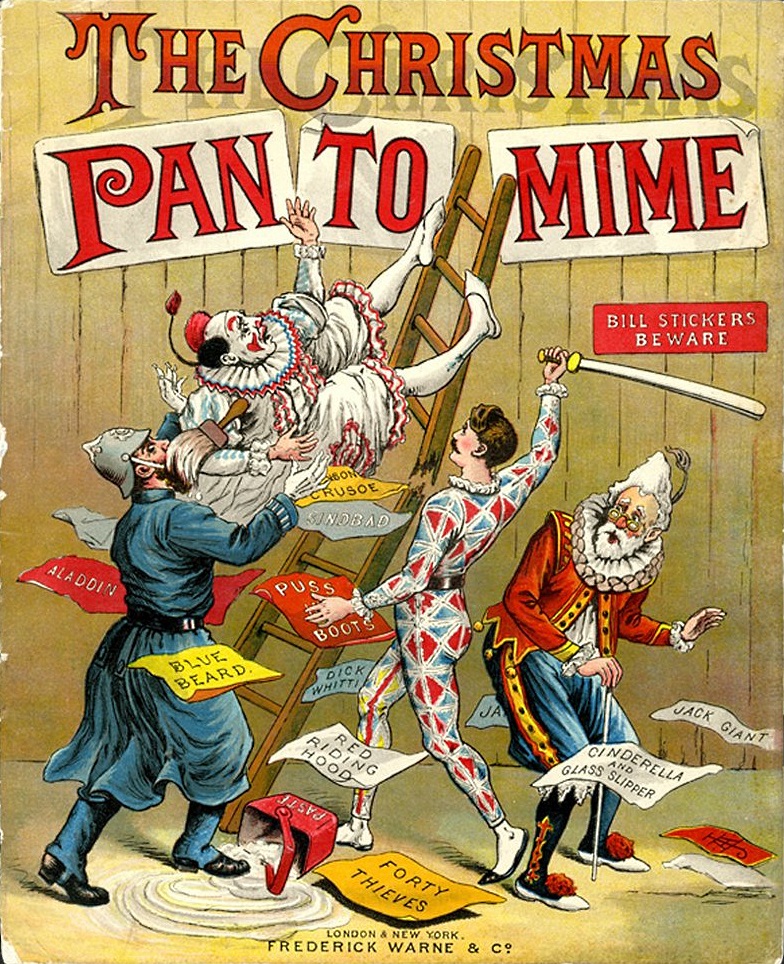|
Clown
A clown is a person who performs comedy and arts in a state of open-mindedness using physical comedy, typically while wearing distinct makeup or costuming and reversing folkway-norms. History The most ancient clowns have been found in the Fifth Dynasty of Egypt, around 2400 BC. Unlike court jesters, clowns have traditionally served a socio-religious and psychological role, and traditionally the roles of priest and clown have been held by the same persons. Peter Berger writes, "It seems plausible that folly and fools, like religion and magic, meet some deeply rooted needs in human society." For this reason, clowning is often considered an important part of training as a physical performance discipline, partly because tricky subject matter can be dealt with, but also because it requires a high level of risk and play in the performer. In anthropology, the term ''clown'' has been extended to comparable jester or fool characters in non-Western cultures. A society in which ... [...More Info...] [...Related Items...] OR: [Wikipedia] [Google] [Baidu] |
Circus Clown
Clowns have always been an integral part of the circus, offering a source of amusement for patrons and providing relief from the array of animal acts and performances by acrobats and novelty artistes. Traditional types Traditionally, there are three basic types of clowns that appear in the circus: the whiteface, the auguste and the character. Nowadays a fourth type, the tramp or hobo clown, is often recognized separately, even though, technically, it should be considered as another character clown. Each of these types of clown may wear a makeup that is either ''neat'' (slightly exaggerated) or ''grotesque'' (wildly exaggerated). There is no single, absolute definition of what constitutes each clown type, with international performers encompassing an extremely wide range of styles, from the classical to the innovative. The whiteface clown The whiteface (or white clown) holds the highest status in the clown hierarchy and is the oldest of the clown archetypes. In modern times, when ... [...More Info...] [...Related Items...] OR: [Wikipedia] [Google] [Baidu] |
Clown Society
Clown society is a term used in anthropology and sociology for an organization of comedic entertainers (Heyoka or "clowns") who have a formalized role in a culture or society. Description and function Sometimes clown societies have a sacred role, to represent a trickster character in religious ceremonies. Other times the purpose served by members of a clown society is only to parody excessive seriousness, or to deflate pomposity. In the sense of how clowns function in their culture: * A clown shows what is wrong with the ordinary way of doing things. * A clown shows how to do ordinary things the "wrong way". By doing ordinary things "the wrong way" the clown reveals what would otherwise be perceived as the serious or true state of things in a different fashion. Members of a clown society may dress in a special costume reserved for clowns, which is often a ridiculously extreme or improper form of normal dress. Some members paint their body with horizontal black and white stripes, w ... [...More Info...] [...Related Items...] OR: [Wikipedia] [Google] [Baidu] |
Joseph Grimaldi
Joseph Grimaldi (18 December 1778 – 31 May 1837) was an English actor, comedian and dancer, who became the most popular English entertainer of the Regency era.Byrne, Eugene"The patient" Historyextra.com, 13 April 2012 In the early 1800s, he expanded the role of Clown in the harlequinade that formed part of British pantomimes, notably at the Theatre Royal, Drury Lane and the Sadler's Wells and Covent Garden theatres. He became so dominant on the London comic stage that the harlequinade role of Clown became known as "Joey", and both the nickname and Grimaldi's whiteface make-up design were, and still are, used by other types of clowns. Grimaldi originated catchphrases such as "Here we are again!", which continue to feature in modern pantomimes. Born in London to an entertainer father, Grimaldi began to perform as a child, making his stage debut at Drury Lane in 1780. He became successful at the Sadler's Wells Theatre the following year; his first major role was as Little ... [...More Info...] [...Related Items...] OR: [Wikipedia] [Google] [Baidu] |
Pueblo Clown
The Pueblo clowns (sometimes called sacred clowns) are jesters or tricksters in the Kachina religion (practiced by the Pueblo natives of the southwestern United States). It is a generic term, as there are a number of these figures in the ritual practice of the Pueblo people. Each has a unique role; belonging to separate Kivas (secret societies or confraternities) and each has a name that differs from one mesa or pueblo to another. Roles The clowns perform monthly rituals, summer (for rain), November - for the gods, for curing society, black magic. Among the Hopi/Tewa there are four distinct clowns. The Koyi'msĭ (also called Ho'tomeli'pung Tewa. Ta'chûktĭ); Chüʳkü'wĭmkya; Pai'yakyamü or Koyala; Koyi'msĭ (also called Ta'chûktĭ) and Pi'ptuyakyamü (or "arrivals"). In order for a clown to perform meaningful social commentary via humor, the clown's identity must usually be concealed. The sacred clowns of the Pueblo people, however, do not employ masks but rely on body ... [...More Info...] [...Related Items...] OR: [Wikipedia] [Google] [Baidu] |
Circus
A circus is a company of performers who put on diverse entertainment shows that may include clowns, acrobats, trained animals, trapeze acts, musicians, dancers, hoopers, tightrope walkers, jugglers, magicians, ventriloquists, and unicyclists as well as other object manipulation and stunt-oriented artists. The term ''circus'' also describes the performance which has followed various formats through its 250-year modern history. Although not the inventor of the medium, Philip Astley is credited as the father of the modern circus. In 1768, Astley, a skilled equestrian, began performing exhibitions of trick horse riding in an open field called Ha'Penny Hatch on the south side of the Thames River, England. In 1770, he hired acrobats, tightrope walkers, jugglers and a clown to fill in the pauses between the equestrian demonstrations and thus chanced on the format which was later named a "circus". Performances developed significantly over the next fifty years, with large-scale theat ... [...More Info...] [...Related Items...] OR: [Wikipedia] [Google] [Baidu] |
Canadian Clowning
The Canadian Clowning technique is a mask-based style of performance created by Richard Pochinko."Canadian clown theatre goes to a whole new level". ''Victoria Times-Colonist'', March 13, 2005. Also known as the "Pochinko Method" or "Clown Through Mask", seven masks are used, each representing one of the six physical directions (North, South, East, West, Above-above and Below-below). The final, seventh, mask is the clown nose. Variations include a three-mask technique (based on the three polarities) and a six-in-one mask technique. Pochinko taught clowning as a sort of "reverse therapy", in which instead of ridding oneself of anxieties, the clown performer leans into their own insecurities and foibles in order to package them as comedy. "Get applauded for your idiosyncrasies" was one of his key mottos as a trainer. According to Michael "Mump" Kennard, one of the most prominent practitioners and trainers of Canadian clowning since Pochinko's death in 1989, "Clowns should be fun no ... [...More Info...] [...Related Items...] OR: [Wikipedia] [Google] [Baidu] |
Heyoka
The heyoka (, also spelled "haokah," "heyokha") is a kind of sacred clown in the culture of the Sioux (Lakota and Dakota people) of the Great Plains of North America. The heyoka is a contrarian, jester, and satirist, who speaks, moves and reacts in an opposite fashion to the people around them. Only those having visions of the thunder beings of the west, the , and who are recognized as such by the community, can take on the ceremonial role of the heyoka. The Lakota medicine man, Black Elk, described himself as a ''heyoka'', saying he had been visited as a child by the thunder beings. Social role The is thought of as being in charge for above and below, or are more in charge for the dead, instead of the living. This manifests by their doing not always everything like the others. For example, if food is scarce, a may sit around and complain about how full he is; during a baking hot heat wave, a might shiver with cold and put on gloves and cover himself with a thick blanket. ... [...More Info...] [...Related Items...] OR: [Wikipedia] [Google] [Baidu] |
Richard Pochinko
Richard Pochinko (1946–1989) was a notable Canadian clown trainer who developed a new style of mask/clown performance training, known as the "Pochinko technique". Originally from Selkirk, Manitoba, he was based primarily in Toronto, Ontario and founded the city's Theater Resource Centre."Richard Pochinko: Talented artist developed Canadian form of clowning". ''The Globe and Mail'', June 9, 1989. The "Pochinko technique" for which he is known combined both European and First Nations traditions of masked and clown performance. Notable figures who studied under Pochinko included Karen Hines, Cheryl Cashman, Nion, Tantoo Cardinal, Sue Morrison, Sara Tilley and the duo Mump and Smoot. Pochinko was gay, and was the partner of Gabriel Manseau."On and Off Stage". ''Toronto Sports and Cultural Centre Magazine'', June 21, 1989. He died in 1989 of AIDS-related causes. See also *Canadian clowning The Canadian Clowning technique is a mask-based style of performance created by Richard ... [...More Info...] [...Related Items...] OR: [Wikipedia] [Google] [Baidu] |
Comedy
Comedy is a genre of fiction that consists of discourses or works intended to be humorous or amusing by inducing laughter, especially in theatre, film, stand-up comedy, television, radio, books, or any other entertainment medium. The term originated in ancient Greece: in Athenian democracy, the public opinion of voters was influenced by political satire performed by comic poets in theaters. The theatrical genre of Greek comedy can be described as a dramatic performance pitting two groups, ages, genders, or societies against each other in an amusing '' agon'' or conflict. Northrop Frye depicted these two opposing sides as a "Society of Youth" and a "Society of the Old". A revised view characterizes the essential agon of comedy as a struggle between a relatively powerless youth and the societal conventions posing obstacles to his hopes. In this struggle, the youth then becomes constrained by his lack of social authority, and is left with little choice but to resort to ruses w ... [...More Info...] [...Related Items...] OR: [Wikipedia] [Google] [Baidu] |
Harlequinade
''Harlequinade'' is a British comic theatrical genre, defined by the ''Oxford English Dictionary'' as "that part of a pantomime in which the harlequin and clown play the principal parts". It developed in England between the 17th and mid-19th centuries. It was originally a slapstick adaptation or variant of the Commedia dell'arte, which originated in Italy and reached its apogee there in the 16th and 17th centuries. The story of the Harlequinade revolves around a comic incident in the lives of its five main characters: Harlequin, who loves Columbine; Columbine's greedy and foolish father Pantaloon (evolved from the character Pantalone), who tries to separate the lovers in league with the mischievous Clown; and the servant, Pierrot, usually involving chaotic chase scenes with a bumbling policeman. Originally a mime (silent) act with music and stylised dance, the harlequinade later employed some dialogue, but it remained primarily a visual spectacle. Early in its development, it ach ... [...More Info...] [...Related Items...] OR: [Wikipedia] [Google] [Baidu] |
Harlequinade
''Harlequinade'' is a British comic theatrical genre, defined by the ''Oxford English Dictionary'' as "that part of a pantomime in which the harlequin and clown play the principal parts". It developed in England between the 17th and mid-19th centuries. It was originally a slapstick adaptation or variant of the Commedia dell'arte, which originated in Italy and reached its apogee there in the 16th and 17th centuries. The story of the Harlequinade revolves around a comic incident in the lives of its five main characters: Harlequin, who loves Columbine; Columbine's greedy and foolish father Pantaloon (evolved from the character Pantalone), who tries to separate the lovers in league with the mischievous Clown; and the servant, Pierrot, usually involving chaotic chase scenes with a bumbling policeman. Originally a mime (silent) act with music and stylised dance, the harlequinade later employed some dialogue, but it remained primarily a visual spectacle. Early in its development, it ach ... [...More Info...] [...Related Items...] OR: [Wikipedia] [Google] [Baidu] |
Jester
A jester, court jester, fool or joker was a member of the household of a nobleman or a monarch employed to entertain guests during the medieval and Renaissance eras. Jesters were also itinerant performers who entertained common folk at fairs and town markets, and the discipline continues into the modern day, where jesters perform at historical-themed events. During the Middle Ages, jesters are often thought to have worn brightly colored clothes and eccentric hats in a motley pattern. Their modern counterparts usually mimic this costume. Jesters entertained with a wide variety of skills: principal among them were song, music, and storytelling, but many also employed acrobatics, juggling, telling jokes (such as puns, stereotypes, and imitation), and performing magic tricks. Much of the entertainment was performed in a comic style. Many jesters made contemporary jokes in word or song about people or events well known to their audiences. Etymology The modern use of the English w ... [...More Info...] [...Related Items...] OR: [Wikipedia] [Google] [Baidu] |







